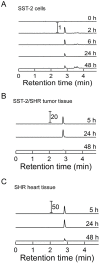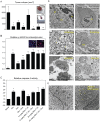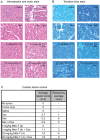Mito-tempol and dexrazoxane exhibit cardioprotective and chemotherapeutic effects through specific protein oxidation and autophagy in a syngeneic breast tumor preclinical model
- PMID: 23940596
- PMCID: PMC3734284
- DOI: 10.1371/journal.pone.0070575
Mito-tempol and dexrazoxane exhibit cardioprotective and chemotherapeutic effects through specific protein oxidation and autophagy in a syngeneic breast tumor preclinical model
Abstract
Several front-line chemotherapeutics cause mitochondria-derived, oxidative stress-mediated cardiotoxicity. Iron chelators and other antioxidants have not completely succeeded in mitigating this effect. One hindrance to the development of cardioprotectants is the lack of physiologically-relevant animal models to simultaneously study antitumor activity and cardioprotection. Therefore, we optimized a syngeneic rat model and examined the mechanisms by which oxidative stress affects outcome. Immune-competent spontaneously hypertensive rats (SHRs) were implanted with passaged, SHR-derived, breast tumor cell line, SST-2. Tumor growth and cytokine responses (IL-1A, MCP-1, TNF-α) were observed for two weeks post-implantation. To demonstrate the utility of the SHR/SST-2 model for monitoring both anticancer efficacy and cardiotoxicity, we tested cardiotoxic doxorubicin alone and in combination with an established cardioprotectant, dexrazoxane, or a nitroxide conjugated to a triphenylphosphonium cation, Mito-Tempol (4) [Mito-T (4)]. As predicted, tumor reduction and cardiomyopathy were demonstrated by doxorubicin. We confirmed mitochondrial accumulation of Mito-T (4) in tumor and cardiac tissue. Dexrazoxane and Mito-T (4) ameliorated doxorubicin-induced cardiomyopathy without altering the antitumor activity. Both agents increased the pro-survival autophagy marker LC3-II and decreased the apoptosis marker caspase-3 in the heart, independently and in combination with doxorubicin. Histopathology and transmission electron microscopy demonstrated apoptosis, autophagy, and necrosis corresponding to cytotoxicity in the tumor and cardioprotection in the heart. Changes in serum levels of 8-oxo-dG-modified DNA and total protein carbonylation corresponded to cardioprotective activity. Finally, 2D-electrophoresis/mass spectrometry identified specific serum proteins oxidized under cardiotoxic conditions. Our results demonstrate the utility of the SHR/SST-2 model and the potential of mitochondrially-directed agents to mitigate oxidative stress-induced cardiotoxicity. Our findings also emphasize the novel role of specific protein oxidation markers and autophagic mechanisms for cardioprotection.
Conflict of interest statement
Figures






Similar articles
-
Early alterations in heart gene expression profiles associated with doxorubicin cardiotoxicity in rats.Cancer Chemother Pharmacol. 2010 Jul;66(2):303-14. doi: 10.1007/s00280-009-1164-9. Epub 2009 Nov 14. Cancer Chemother Pharmacol. 2010. PMID: 19915844
-
Doxorubicin-induced carbonylation and degradation of cardiac myosin binding protein C promote cardiotoxicity.Proc Natl Acad Sci U S A. 2014 Feb 4;111(5):2011-6. doi: 10.1073/pnas.1321783111. Epub 2014 Jan 21. Proc Natl Acad Sci U S A. 2014. PMID: 24449919 Free PMC article.
-
Doxorubicin-induced cardiotoxicity is suppressed by estrous-staged treatment and exogenous 17β-estradiol in female tumor-bearing spontaneously hypertensive rats.Biol Sex Differ. 2018 Jun 15;9(1):25. doi: 10.1186/s13293-018-0183-9. Biol Sex Differ. 2018. PMID: 29907135 Free PMC article.
-
The Role of AMPK Activation for Cardioprotection in Doxorubicin-Induced Cardiotoxicity.Cardiovasc Drugs Ther. 2020 Apr;34(2):255-269. doi: 10.1007/s10557-020-06941-x. Cardiovasc Drugs Ther. 2020. PMID: 32034646 Free PMC article. Review.
-
Dexrazoxane: a cardioprotectant for pediatric cancer patients receiving anthracyclines.J Pediatr Oncol Nurs. 2015 May-Jun;32(3):178-84. doi: 10.1177/1043454214554008. Epub 2014 Nov 3. J Pediatr Oncol Nurs. 2015. PMID: 25366577 Review.
Cited by
-
Metal-induced oxidative stress and human plasma protein oxidation after SARS-CoV-2 infection.Sci Rep. 2023 Feb 10;13(1):2441. doi: 10.1038/s41598-023-29119-5. Sci Rep. 2023. PMID: 36765106 Free PMC article.
-
Efficacy of Dexrazoxane in Preventing Anthracycline Cardiotoxicity in Breast Cancer.JACC CardioOncol. 2019 Sep 24;1(1):68-79. doi: 10.1016/j.jaccao.2019.08.003. eCollection 2019 Sep. JACC CardioOncol. 2019. PMID: 34396164 Free PMC article.
-
Antiproliferative effects of mitochondria-targeted cationic antioxidants and analogs: Role of mitochondrial bioenergetics and energy-sensing mechanism.Cancer Lett. 2015 Aug 28;365(1):96-106. doi: 10.1016/j.canlet.2015.05.016. Epub 2015 May 21. Cancer Lett. 2015. PMID: 26004344 Free PMC article.
-
Understanding the Mechanisms of Chemotherapy-Related Cardiotoxicity Employing hiPSC-Derived Cardiomyocyte Models for Drug Screening and the Identification of Genetic and Epigenetic Variants.Int J Mol Sci. 2025 Apr 23;26(9):3966. doi: 10.3390/ijms26093966. Int J Mol Sci. 2025. PMID: 40362211 Free PMC article. Review.
-
Aspalathin Reverts Doxorubicin-Induced Cardiotoxicity through Increased Autophagy and Decreased Expression of p53/mTOR/p62 Signaling.Molecules. 2017 Sep 22;22(10):1589. doi: 10.3390/molecules22101589. Molecules. 2017. PMID: 28937626 Free PMC article.
References
-
- Cardinale D, Colombo A, Torrisi R, Sandri MT, Civelli M, et al. (2010) Trastuzumab-induced cardiotoxicity: clinical and prognostic implications of troponin I evaluation. J Clin Oncol 28: 3910–3916. - PubMed
-
- Mellor HR, Bell AR, Valentin JP, Roberts RR (2011) Cardiotoxicity associated with targeting kinase pathways in cancer. Toxicol Sci: 14–32. - PubMed
-
- Ferrans VJ, Clark JR, Zhang J, Yu ZX, Herman EH (1997) Pathogenesis and prevention of doxorubicin cardiomyopathy. Tsitologiia 39: 928–937. - PubMed
-
- Levine RL, Stadtman ER (2001) Oxidative modification of proteins during aging. Exp Gerontol 36: 1495–1502. - PubMed
Publication types
MeSH terms
Substances
Grants and funding
LinkOut - more resources
Full Text Sources
Other Literature Sources
Medical
Research Materials
Miscellaneous

